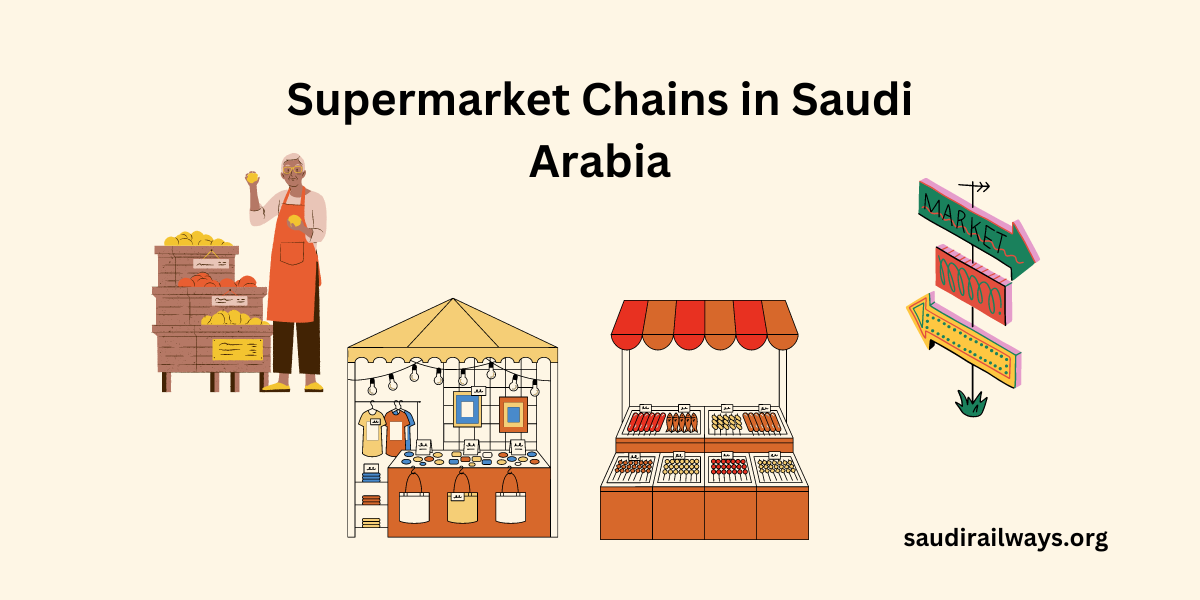Saudi Arabia is one of the largest and most markets in the Middle East for exporters of food and beverages. It has a population of more than 34 million, a high per capita income, and a high demand for variety and quality; the kingdom offers choices for foreign suppliers. However, to get success in this market, exporters need to understand the preferences and dynamics of the local consumers, also the characteristics and structure of the retail sector.
Also Read: 5 Riyal Shops Near Me
In this article, we will give a supermarket chain overview in Saudi Arabia, highlighting their market distribution channels, share, product range, and consumer profile. We will also give some insights and tips for exporters who want to enter or enhance their presence in this market.
Contents
The Retail Landscape in Saudi Arabia
The retail sector in Saudi Arabia is dominated by hypermarkets and supermarkets, which account for about 70% of the food retail sales. These are modern, large stores which are well-stocked that offer a number of products, like dairy, bakery, frozen, canned, fresh produce, meat, and packaged foods, as non-food items like electronics, clothing, household goods, and cosmetics. Hypermarkets and supermarkets are popular out of consumers because they offer quality, convenience, and competitive prices.
The hypermarket and supermarket segment is highly concentrated, with some players controlling most of the market. According to a report by some sources, the top 5 supermarket chains in Saudi Arabia in 2019 were:
- Panda Retail Company, with a market share of 28.6% and 230 stores across the kingdom.
- Abdullah Al Othaim Markets, with a market share of 15.4% and 227 stores.
- BinDawood Holding, with a market share of 12.7% and 73 stores.
- Lulu Saudi Hypermarkets, with a market share of 9.8% and 20 stores.
- Saudi Marketing Company (Farm Superstores), with a market share of 7.6% and 79 stores.
These five chains accounted for 74.1% of the total supermarket sales in 2019, while the remaining 25.9% was distributed among other smaller and regional players, like Al Raya, Carrefour, Al Jazira, Tamimi Markets, and Danube.
The Distribution Channels in Saudi Arabia
The distribution channels in Saudi Arabia are fragmented and complex, with multiple intermediaries involved in the supply chain. Exporters who want to sell their products in the Saudi market need to work with distributors, wholesalers, local importers, and retailers, who have the required connections, licenses, and expertise to handle the regulations, logistics, customs, and products marketing.
The main distribution channel for food and beverage products in Saudi Arabia is the following:
- Exporters sell their products to importers, who are responsible for getting the import permits, which pays the customs duties and fees, and clearing the products at the ports of entry.
- Importers sell their products to distributors, who are responsible for transporting, storing, and delivering the retailer’s products. Distributors may also provide some promotional and marketing support for the products.
- Distributors sell their products to wholesalers, who are responsible for supplying the products to smaller and independent retailers, like mini-markets, convenience stores, and specialty shops.
- Distributors may also sell their products directly to modern and large retailers, like hypermarkets and supermarkets, who have their own distribution and warehouses centers.
Some importers may also act as wholesalers or distributors, which depends on their capacity. Some retailers may also import their own products directly from the exporters, and bypassing the intermediaries. However, these are exceptions rather than the norm, and most exporters still need to rely on the made distribution network to reach the consumers in Saudi.
The Product Range in Saudi Arabia
The product range in Saudi Arabia is dynamic and diverse, which reflects the changing preferences and tastes of the consumers. The Saudi market offers a mix of imported and local products, with the accounting for about 80% of the food consumption. The main sources of food imports are the India, Egypt, UAE, Brazil, and the US.
The Saudi consumers are looking for variety, quality, and convenience in their food choices. They are also becoming more aware of the environment, conscious of hte health, and socially responsible. Some of the key opportunities and trends for food and beverage products in Saudi Arabia are:
- Halal products: Halal products are products that matches with the Islamic dietary laws, which stops the consumption of some animal by-products, pork, and alcohol. Halal products are necessary for all food and beverage products sold in Saudi Arabia, and exporters need to get the certification of halal from the Saudi Food and Drug Authority (SFDA) or an approved halal body in their country of origin.
- Organic products: These are products that are produced without the use of fertilizers, hormones, antibiotics, synthetic pesticides, or genetically modified organisms. Organic products are getting popularity among the Saudi consumers, who are looking for healthy, natural, and safe food options. Organic products are regulated by the SFDA, and exporters need to get the organic certification from the SFDA or an approved organic body in their country of origin.
- Functional products: These are products that have differnet health benefits, like vitamins, antioxidants, minerals, probiotics, or omega-3 fatty acids. Functional products are good to the Saudi consumers, who are looking for products that can increase their energy, immunity, digestion, or beauty. These products are regulated by the SFDA, and exporters need to give scientific proof to support their health claims.
- Convenience products: These are products that are easy to make, consume, or store, like ready meals, snacks, beverages, sauces, or frozen foods. They are in high demand among the Saudi consumers, who are looking for products that can save them time, effort, and money. They are regulated by the SFDA, and exporters need to ensure that their products meet the safety, quality, and labeling standards.
The Consumer Profile in Saudi Arabia
The consumer profile in Saudi Arabia is sophisticated and diverse, influenced by different factors lke age, gender, lifestyle, income, education, and culture. The Saudi consumers are not a homogeneous group, but rather a segmented market with different preferences, needs, and behaviors. Some of the key characteristics and segments of the Saudi consumers are:
- High-income consumers: They are consumers who have a high purchasing power and a high disposable income. They are well-educated, well-traveled, and well-informed. They are looking for premium, imported, and branded products that can satisfy their quality, variety, and luxury needs. They are also willing to pay a premium price for these products, as long as they found them as valuable and worth it.
- Middle-income consumers: They are consumers who have a moderate disposable income and a moderate purchasing power. They are young, urban, and aspirational. They are looking for convenient, affordable, and trendy products that can satisfy their convenience, variety, and novelty needs. They are also willing to try new products, as long as they perceive them as beneficial and attractive.
- Low-income consumers: They are consumers who have a low disposable income and a low purchasing power. They are mainly older, rural, and traditional. They are looking for basic, local, and familiar products that can satisfy their necessity, quality, and value needs. They are also loyal to products which are existing, as long as they find them as reliable and consistent.
Tips and Insights for Exporters
Exporting food and beverage products to Saudi Arabia can be a rewarding and profitable venture, but it also requires careful planning, research, and preparation. Here are some tips for exporters who want to enter or expand their presence in this market:
- Know the market first: The Saudi market is competitive and complex, and exporters need to understand the market trends, opportunities, size, structure, challenges, and regulations before entering it. Exporters should conduct a thorough market analysis, know their target segments, and develop a market entry strategy that suits their capabilities and objectives.
- Understand the consumers: The Saudi consumers are diverse and exporters need to understand their preferences, needs, and behaviors before reaching them. Exporters should conduct a comprehensive consumer research, segment their customers, and tailor their products, promotions, prices, and placements to their needs and expectations.
- Search the competitors: The Saudi market is crowded, and exporters need to understand their strengths, weaknesses, opportunities, and threats of the competitors before competing with them. Exporters should conduct a detailed competitor analysis, benchmark their products against them, and differentiate their products based on their unique selling competitive and propositions advantages.
- Understand the partners: The Saudi market is complex again, and exporters need to work with reputable and reliable partners who can help them navigate the market and reach the consumers. Exporters should select their partners carefully, based on their experience, network, reputation, and performance. Exporters should also make clear and mutually beneficial agreements with their partners, and have regular and effective communication with them.
Conclusion
Saudi Arabia is a profitable market for food and beverage exporters, but it also need a deep understanding of the market, the competitors, the consumers, and the partners. By following the tips and insights provided in this article, exporters can increase their chances of success and growth in this market.
For more such amazing and helpful content, keep reading our article daily.

I am a passionate technology and business enthusiast, constantly exploring the intersection where innovation meets entrepreneurship. With a keen eye for emerging trends and a deep understanding of market dynamics, I provide insightful analysis and commentary on the latest advancements shaping the tech industry.
